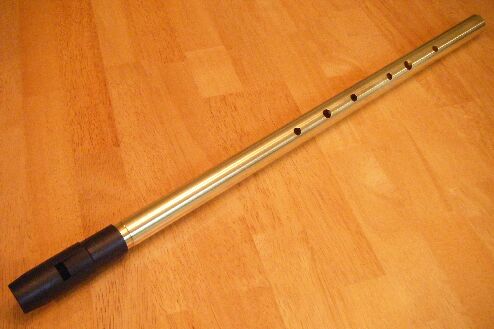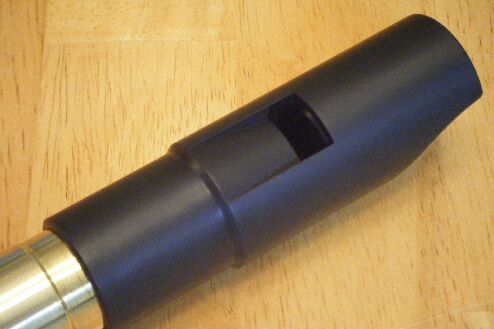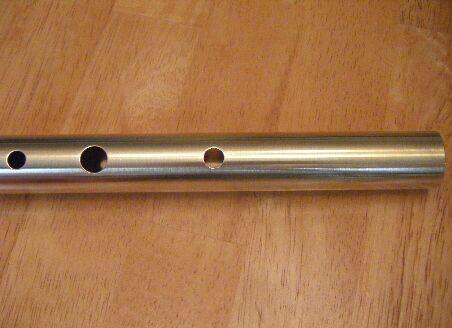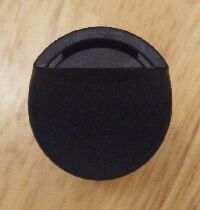Maker - Humphrey Whistles (Gary Humphrey) webpages.charter.net/raindog1970/
Material - Brass Body with Black Acetal Head
Dimensions: Length - 22 5/8ths" (with head pushed all the way in)
Distance between 1st and 3rd bottom holes - 3"
Distance between 1st and 2nd bottom holes - 1 13/16ths"
Diameter of 2nd hole from bottom - 7/16ths"
Bore - 7/8ths"
Weight - 9 oz
Price at time of review - $175 US direct from Maker.
While
I don't have that many makers of low whistles left to acquire for
review purposes, deciding just which one to get next has become a bit
of a challenge. So when Gary Humphrey posted on the Chiff and Fipple
whistle forum that he had modified the design of the blade on his low
whistles, I took it as a sign (or an excuse depending on how you look
at it!) Ordering from Mr. Humphrey was a very pleasant experience, emails
were responded to quickly and in detail, and it only took about two
weeks from the time I ordered to receive the whistle reviewed
here.




Appearance: Humphrey whistles are part of the family of plastic head, metal body low whistles which include Howard, Syn, and Kerry to
name a few. However, Humphrey low whistles have managed to avoid
that "big head" on a stick look, as the head is only slightly wider
than the body. Mr. Humphrey mainly makes his whistle bodies out
of brass, but occasionally uses aluminum as well. The matte black of
the acetal
head looks very nice against the gold of the brass body, and I imagine
it would look
very sharp against the silver of an aluminum body as well. The head
looks very clean and smooth, unlike some other plastic heads which can
have mold lines and other loose or sharp flashing. The whistle is
tunable by pushing or pulling the head on the end of the body tube,
which fits snuggly without being too tight or too loose. While the
mouth
piece is somewhat larger than usual, it is not uncomfortably so, like
say a Susato. The
overall body diameter is slightly smaller than most other low D's (most
likely due to a thinner body wall), and the finger/tone holes are also
smaller than is typical, both of which combine to create a whistle that
I found very comfortable on the hands to play (although this of course
would be
subject to ones own personal hand size.) The edges of the tone holes
were a little on the sharp side, and possibly could do with some
rounding/smoothing, but this might not be possible given the
aforementioned thinness of the body wall. Being a brass whistle, it is
a bit on the heavy side, coming in at 9oz, but is certainly
not as heavy as say a Chieftain gold! All in all I found this whistle
to be smart looking and easy on the eyes. I especially liked how the
tuning mechanism was not overly noticeable and did not take away from
the clean lines and overall looks of the whistle.
Tone: When describing the tone of this whistle I keep wanting to use words like delicate, dainty and sweet, but I don't want to give the wrong impression, I mean this in a good way! Of all the low whistles I have played, this one has a tone that most puts me in mind of the traditional high D "cheapies", like generations, clarkes and feadogs. It has a fair amount of breath apparent in the tone which has a nicely turbulent quality along with a healthy dose of chiff.
Volume: I would describe the volume of this whistle as being somewhat quiet in comparison to other Low D's I have played. But instead of being a draw back, this somehow adds to the quality of tone I previously described. While certainly not a session whistle, it would make for a good practice or recording whistle.
Backpressure/air requirement: This whistle has a moderate to low amount of backpressure. Unfortunately it does have a fairly low break point threshold in the first octave, especially on the low E note. It sounds and responds best when blown softly (which I'm sure goes along way to explaining why it is on the quiet side) and if the notes in the first octave are blown too hard, the tone becomes airy and somewhat tinny. However, the low D fundamental is nicely resonant and does allow for a little more "push" than the other notes in the first octave. While it doesn't have a high amount of backpressure, the fact that it likes to be blown softly does give it a somewhat lower than average air requirement.
Responsiveness: This whistle is nicely responsive, however, it seems to "squawk" easily when executing rolls in either octave.
Clogging: I did not experience any major clogging issues with this whistle.
Tuning: This whistle has a ring engraved on the tenon of the body to show the best place to set the head for tuning purposes. However I found that the head had to be pulled out significantly farther in order to have the first octave play in tune. But even with this adjustment, the low E was around 20 cents sharp and all the notes in the second octave from the F# on up were 20 cents flat. Ironically, if you put the head in line with the engraved line, it brings these high notes into tune, but of course this makes the first octave notes sharp. The C natural is good to go with the OXXXOO fingering.
Sound clip: The Sailor's Wife
Summary: Despite several features that I might normally refer to as "issues" on other whistles, in the end I was quite taken with this whistle, especially in the playability and tone department. Excellent craftsmanship and a very nice whistle at a very nice price!
Four holes.

Tone: When describing the tone of this whistle I keep wanting to use words like delicate, dainty and sweet, but I don't want to give the wrong impression, I mean this in a good way! Of all the low whistles I have played, this one has a tone that most puts me in mind of the traditional high D "cheapies", like generations, clarkes and feadogs. It has a fair amount of breath apparent in the tone which has a nicely turbulent quality along with a healthy dose of chiff.
Volume: I would describe the volume of this whistle as being somewhat quiet in comparison to other Low D's I have played. But instead of being a draw back, this somehow adds to the quality of tone I previously described. While certainly not a session whistle, it would make for a good practice or recording whistle.
Backpressure/air requirement: This whistle has a moderate to low amount of backpressure. Unfortunately it does have a fairly low break point threshold in the first octave, especially on the low E note. It sounds and responds best when blown softly (which I'm sure goes along way to explaining why it is on the quiet side) and if the notes in the first octave are blown too hard, the tone becomes airy and somewhat tinny. However, the low D fundamental is nicely resonant and does allow for a little more "push" than the other notes in the first octave. While it doesn't have a high amount of backpressure, the fact that it likes to be blown softly does give it a somewhat lower than average air requirement.
Responsiveness: This whistle is nicely responsive, however, it seems to "squawk" easily when executing rolls in either octave.
Clogging: I did not experience any major clogging issues with this whistle.
Tuning: This whistle has a ring engraved on the tenon of the body to show the best place to set the head for tuning purposes. However I found that the head had to be pulled out significantly farther in order to have the first octave play in tune. But even with this adjustment, the low E was around 20 cents sharp and all the notes in the second octave from the F# on up were 20 cents flat. Ironically, if you put the head in line with the engraved line, it brings these high notes into tune, but of course this makes the first octave notes sharp. The C natural is good to go with the OXXXOO fingering.
Sound clip: The Sailor's Wife
Summary: Despite several features that I might normally refer to as "issues" on other whistles, in the end I was quite taken with this whistle, especially in the playability and tone department. Excellent craftsmanship and a very nice whistle at a very nice price!
Four holes.